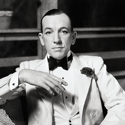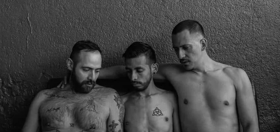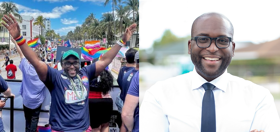Are there really people out there who are attracted to more than one gender? Do male bisexuals exist? Is true bisexuality actually a thing?
Related Post: Study: male bottlenose-dolphins engage in extensive bisexuality and exclusive homosexuality
You’ve heard the arguments that attempt to diminish bisexuality as an identity. Some say that bisexuality is a baby step that makes it easier for a person to come out as gay eventually. Others say bisexuality is a youthful fad until its time to settle down, as gay or straight.
We here at the Science of Sin looked into what researchers have found to see if they can help settle the debate.
How about we take this to the next level?
Our newsletter is like a refreshing cocktail (or mocktail) of LGBTQ+ entertainment and pop culture, served up with a side of eye-candy.
1. How to study sexual orientation
The roughest measure to determine sexual orientation is recording people’s sexual and romantic histories. By tallying up a person’s sexual partners, you get an idea of their sexual orientation.
For more insight into sexual arousal, scientists measure blood flow to the genitals when people are shown various types of sexuality explicit imagery. If there’s more blood flow to the genitals, researchers assume that means the subject is turned on by what she or he sees. So what does the data say?
2. Women seem more likely to be bisexual …
Women are more likely show vaginal arousal to and form romantic bonds with both men and women. Men on the other hand appear more fixed – at least in terms of which gender sends blood to their penises.
And some studies have shown that men who say they are bisexual are really only aroused by other men. This leads credence to the somewhat stereotyped notion that bisexual males are really just gay.
3. But we might just be bad at studying bisexual men
However, in recent genital arousal studies with better recruitment methods, scientists were able to find clear male bisexual arousal patterns. This illuminates another problem with this type of research. We rely on people telling researchers their sexual background – which can be unreliable since people are often ashamed to discuss what really turns them on.
4. Or maybe we’re all a little bi
But in a way, bisexuality is a broad, almost meaningless term – encapsulating everyone and no one. Research is illuminating that sexuality should be seen as fluid rather than fixed.
Many self-identified straight people report participating in and enjoying sexual relations with the same sex at one point in their life – usually in adolescence but sometimes later in life. In prisons, people enter loving, affectionate same sex relationships that they never would on the outside. And many people report that an emotional connection was so intense it turned sexual — even though it was with someone of the gender they typically were not attracted to.
Some sociologists argue that the society you live in plays a big part in the genders you enjoy sleeping with. They point to the ancient Greek, Native Americans, Japanese and numerous other societies throughout history where it appears more people engaged in homosexual experiences because the culture was more tolerant.
Thus, we wonder if while we might be predisposed to certain sexual attractions, in a way we’re all “bisexual.” Sexuality seems more complex than researchers previously thought, and might depend more on the culture we grew up in and the environment we live in.
Pleasure, intimacy, connection and love just might be less dependent on gender than we might assume.
Are we all bisexuals at heart? Watch Alex and Xander debate the pleasure of bisexuality.
You can also see past Science of Sin posts on the evolution of homosexual men, the wonder of the penis, weight loss, marijuana, testicles and prostate pleasure. Visit our YouTube channel for more sinful videos.
(Sources: LeVay, Simon. Gay, Straight, and the Reason Why: The Science of Sexual Orientation. Oxford: Oxford UP, 2011.
Rosenthal AM, Sylva D, Safron A, Bailey JM. The male bisexuality debate revisited: some bisexual men have bisexual arousal patterns. Arch Sex Behav. 2012 Feb;41(1):135-47.
Weill, Cheryl L. Nature’s Choice: What Science Reveals about the Biological Origins of Sexual Orientation. New York: Routledge, 2009.)



















ted72
The guy in the video is cute.
jason smeds
Only a few men are completely homosexual or completely heterosexual. Most men can swing both ways. It’s just that women don’t approve of it. Women would not approve of their husbands having feelings for other men even if they don’t act on those feelings. It kind of creeps out women.
As for women being more bisexual than men, no way. Women don’t have the genuine and compelling sexuality of men. Therefore, they can’t be more sexual-anything.
Keep in mind that 90% of female sexuality is fake and a form of act for the purpose of obtaining a reward from a male. I’m not saying that women don’t have a sexuality, I’m just saying that much of their sexual behavior is a response to a reward-type scenario in which the man is the reward-giver and she is the reward-receiver.
You only have to note how straight-identifying guys pay women to perform homosexual scenes in porn movies. Here, girl-girl is a form of prostitution – she is rewarded in cash to behave in a certain way sexually, including with other women.
Don’t let the widespread prevalence of girl-girl scenes in “straight” porn movies mislead you into thinking that women are more bisexual than men. They aren’t. It’s not even close.
Bauhaus
@jason smeds:
You start out with something that may have some merit, then you go bat-shit crazy. That’s your modus operandi. Your fixation on prostitution and your hatred of women, leads me to believe your own mother was… Get over it. Move on. Forgive her, and know there are good women, that they enjoy sex for the PLEASURE of sex, and that women who enjoy sex are good people, mothers, sisters, daughters, friends, and human beings.
And speaking of a “genuine and compelling” sexuality, why were women given the gift of multiple orgasms, and not men? Seems genuine and compelling to me.
Masc Pride
#3 pretty much cancels out the idea of #2. Veiled studies have been known to produce drastically different results when it comes to stuff like this. I think women are more likely to openly admit these things, but I’ve not seen anything credible that “leads credence to the somewhat stereotyped notion that bisexual
males are really just gay.” Statements like that are tantamount to telling a gay guy he just “hasn’t met the right girl yet”.
However, I don’t believe all of us are a little bi. Some guys are gay and only gay (Ross Matthews, Carson Kressley, Ambrose Price, etc.), and likewise, there are straight men that are just straight too. I’d hardly consider same-sex interaction during early puberty or at sleep away camp to be bisexuality. True bisexuality is continuous, not just for a moment. Male prison sexuality is mostly rape, domination, humiliation and/or protection, not “loving relationships” (Beecher and Keller weren’t real, guys).
Black Pegasus
“And some studies have shown that men who say they are bisexual are really only aroused by other men. ”
______________
^^^ This is pretty much all that needs to be said. The claims of bisexuality are usually given by some of the most narcissistic men I’ve ever encountered. They are so fucking full of themselves to think both women and men need their attention.
Bauhaus
@Black Pegasus:
“They are so fucking full of themselves to think both women and men need their attention.”
Obviously, you haven’t a clue of what bisexuality is about.
gaym50ish
Bringing up prison relationships and suggesting that sexuality is “fluid” simply plays into the anti-gay argument that we’re not born that way.
We need to acknowledge that Kinsey was correct with his six-point scale, zero being totally homosexual and six being totally heterosexual. Most people are closer to one end or the other, but there are those in the middle as well. So, even trying to DEFINE bisexual is problematic, because you wold have to establish a range within that scale to decide who is really bisexual, and it would be impossible to measure in any scientific way.
So, isn’t it time to abandon the labels and admit that we’re just sexual beings. And that, wherever we are on that scale, we didn’t choose to be there?
gaym50ish
@gaym50ish: Oops! I got the zero and six reversed. Kinzey considered zero to be totally hetero.
Pistolo
@gaym50ish:
Kinsey is always brought up merely because he was the *first* to study sexuality in such a way but it’s important to note that his studies were heinously unscientific by today’s standards. Also, I don’t think it does bisexuals any favors to be categorized as a number on a scale between totally straight and totally gay. Bisexual people are BISEXUAL not half-straight & half-gay. 100% attracted to both genders.
We convolute bisexuality so heavily by trying to make it applicable to straight and gay people, by trying to imply they are part-bi too in order to engender them to the validity of the orientation. That’s why people can’t accept it. People have turned it into this intangible, mystical, complex thing when really it’s just someone’s sexual orientation. That’s it. That’s all. It’s not some omni-present, magical think that could overtake any one of us if we just open our minds. That’s magical thinking, that’s superstition.
Bauhaus
@Pistolo:
“People have turned it into this intangible, mystical, complex thing when really it’s just someone’s sexual orientation. That’s it. That’s all.”
Very well said. The sexual “fluidity” issue may be clouding bisexuality.
notevenwrong
Yes, Kinsey’s one-dimensional scale makes sexuality seem like a zero-sum game, as if being more heterosexual means less homosexual. It doesn’t account for people who are very attracted to the same sex AND very attracted to the opposite sex, for example, or not very attracted to either. A more realistic scale would have at least two numbers, indicating level of attraction to the two genders.
jason smeds
The problem with modern studies on sexuality is that they are colored by the bisexual double standard that is prevalent in porn – ie female bisexuality is embraced by porn whereas male bisexuality is not embraced to anywhere the same extent. It’s an artificial double standard propped up by cash payments to female prostitutes.
The advantage of Kinsey is that he did his studies at a time when porn was virtually unheard of. Therefore, the bisexual double standard had not influenced societal and scientific thinking in the way it has today. His studies were thus free of the artificial bias which favors female bisexuality over male bisexuality.
daveyboy1968
Interesting article. I saw a documentary where they measured genital blood flow in men in response to explicit materials, and the most significant conclusion was that arousal to same sex material correlated directly with lying. The higher a man was on the arousal scale to gay material, the more likely he was to describe himself as straight, and mark ‘0’ for arousal to this material, as they were asked to rate their level of arousal.
And for prison: something like 76% men who class themselves as heterosexual admit to having same sex partners in prison. This proves that sexuality is about ‘potential’ not what you actually do.
CaliKyle
@jason smeds: Could not agree with you more, Jason. I’m gay but in freshman year of college, I had sex with several women on campus (mostly sorority girls) because I was rushing a frat and on the advice of my older brother who was a senior and the fraternity’s president, it wasn’t enough that I was six four, muscular top university swimmer with a baritone voice – unless I told people or they knew me long enough to realize I never looked at or dated girls, people usually didn’t suspect I was gay – he made it a point to tell me to get with girls so none of the brothers would connect the dots and give him shit about our house getting a rep as the gay fraternity. So I did and it was kind of interesting -although not enough to entice me to keep it up once I pledged – but it opened a previously closed window into female sexuality. Nothing scientific, just my takeaway from the experiences I had and the women I got to know: the notion that most girls are bi or gay for the stay is bullshit. They like to play like that’s the case because they know a lot of straight dudes get off on it, but its not who they really are or what they genuinely want to do. And their same sex encounters seem to mostly have been limited to making out and fondling each others tits. On the other hand, my experiences with guys who id’d as straight was completely the opposite of what these so called studies claim – that males are either all the way straight or gay, and the ones who are bi are really just gay. No, guys are much more bi than girls for sure and why wouldnt they be given that their libidos are generally stronger than females, their sexual needs more urgent and demanding. I had sexual relationships with an out gay diver, a closeted gay football player, and all the others were with straight guys, most of whom would get drunk and then suck my dick, a few of whom wanted to be fucked, again defying any stereotypes, the straight guys I encountered wanted to receive not give anal. The only full blown relationship I had lasted for over 2 years and was with one of my straight frat brothers. First year we were just close platonic friends, but then a mutual physical attraction led to a sexual relationship. We were fairly open within our own house, everybody knew and sometimes joked about it to us, but basically we were left to do our thing. So as far as I know, its guys who are more likely to be gay for the stay in college and open to same sex experimentation in general. How many married straight women place ads on Craigslist looking for discreet encounters with other women? The few that might be there are likely placed by their husbands, not them. Meanwhile, there are countless married dudes looking to satisfy their same sex curiosity and needs on the down low.
CaliKyle
@Bauhaus: And speaking of a “genuine and compelling” sexuality, why were women given the gift of multiple orgasms, and not men? Seems genuine and compelling to me.
I’ve had a few experiences with bottoms who would ejaculate two or three times, with just a few minutes in between each, solely from being fucked, so obviously there are some men who have been similarly gifted. However, that’s almost beside the point, Bauhaus. Physiologically, the female orgasm is a fraction as intense or overpowering as a male’s. And that’s when females manage to have an orgasm at all during sexual intercourse. There’s no such thing as a strictly vaginal orgasm. There’s absolutely nothing in terms of the vagina’s structure that would cause a woman to orgasm. It’s all about the clit (mini penis). While there are an almost negligible minority of females who sometimes are able to climax vaginally when only the internal part of the clit is stimulated, the overwhelming majority need direct clitoral stimulation in order to orgasm. And as pleasant and tingly an experience that might be, it still pales next to the powerful sensation of most male’s typical orgasm. Acknowledging this is in no way inherently misogynistic, nor does it mean there aren’t females with rabid libidos to rival any man’s because there certainly are; it’s merely biological, physiological reality. No one ever said life or Mother Nature was fair.
jason smeds
An orgasm occurs when the gamete is released from the body as a result of arousal, and is accompanied by a feeling of intense pleasure. Only men tick all the boxes here. Women may experience pleasure during sex but they do not release the gamete from their bodies, and thus they do not experience orgasm. Their gametes (ova) are released regardless of whether they are aroused or not.
I just thought I’d point this out because there is so much nonsense out there along the lines of “women can do this, women can do that, blah blah blah”. It’s designed to prop up the idea of female superiority over men in the sexuality stakes. It’s complete propaganda which is partly due to the rise of feminism. It has led to this completely false notion that “women are more bisexual than men”.
Let’s make this clear: women are superior in terms of caring for the growing fetus. But men are superior in terms of sexuality, meaning the strength of the sex drive, the duration of fertility, the number of gametes able to be produced in a lifetime etc etc etc.
jason smeds
CaliKyle,
Thanks for your comments. Yours is an important contribution to the debate.
CaliKyle
@jason smeds: An orgasm is not strictly about the release of ejaculate though, Jason; arousal (by way of cns) must reach critical mass first and then the dude orgasms. Release of sperm is only one part of an orgasm, not the entire event. So, women are in fact capable of achieving orgasm exclusively as a result of direct clitoral stimulation, which is almost impossible to achieve through vaginal penetration alone. It’s incompatibilities like this and others between the sexes that remind me of how lucky I am to be gay. Hetero sex is predicated on reproduction, where male homo sex is predicated on pure pleasure. Is male sexuality superior? If the measuring stick has to do with raw pleasure and intensity, then yes, it is.
Dev.C
I kinda agree with the article that the term bisexuality is kinda meaningless for a majority of people, considering that most people are capable of having sex with both genders but are typically attracted to only one (emotional and physically).
I do believe that true bisexuals have a need for a relationship with both sexes at all times, so I find it kind of unrealistic for someone to say they are 100% bisexual when they mostly date one sex over the other.
I know plenty of gay men who have sex with women every blue moon, but would never classify themselves as Bi; I think people just want to appeal to both camps sometimes.
Nixter
Bisexuality is an attraction to both sexes to varying degrees.
Bauhaus
@CaliKyle:
” Hetero sex is predicated on reproduction”
Is that how you felt while banging sorority girls, trying to prove to your big brother that you’re a real man? When will right-wingers and religious zealots admit that heterosexuals, women included, fuck for the pleasure of it? For intimacy, closeness. It isn’t just a gay [male] phenomenon. Sex is pleasurable. Men like it, women like it. Sometimes, procreation is the objective. Sometimes, it’s the unintentional outcome. The difference between humans and animals: we can choose when to procreate, and when to fuck for pleasure.
Also, ejaculation in men doesn’t always accompany orgasm.
nature boy
@CaliKyle: what frat where and when? i was ADPhi at CU in the 80’s, which had the rep as a gay house but no one was openly gay and many acted especially homophobic in order to try and disprove the longstanding rep. I hadn’t yet come out to myself much less publicly and I did some very anti-gay stuff that I’m particularly embarrassed by in hindsight. It seems much better for students today. A campus coming out group support group saved me.
And yup, straight guys always want to bottom !
CaliKyle
@Bauhaus: I’m neither a right winger or a religious zealot, not even remotely. Of course, women have sex for pleasure. My comment re the basis of hetero vs homo sex was not aimed solely at women, so no need to labor under that massive chip on your shoulder on this specific point. Nonetheless, it’s my opinion that hetero sex underscores the inherent sexual incompatibilities between males and females. And, yes, you are correct about males not always ejaculating as a result of orgasm; this is particularly common with males who experience anal orgasms.
CaliKyle
@natwhat frat where and when? i was ADPhi at CU in the 80’s, which had the rep as a gay house but no one was openly gay and many acted especially homophobic in order to try and disprove the longstanding rep. I hadn’t yet come out to myself much less publicly and I did some very anti-gay stuff that I’m particularly embarrassed by in hindsight. It seems much better for students today. A campus coming out group support group saved me.
And yup, straight guys always want to bottom !ure boy:
I graduated in late 2000s from what many consider to be the most prestigious west coast university; my frat is one of the three oldest on campus and I’ll leave it at that. We did not have a rep as a gay house, but there’s some rumbling currently that others are starting to perceive it as such, which is so ironic to me. Honestly, I was never really in the closet. I assumed that a lot of boys were gay which explains why up until middle school I had no compunction about being physically affectionate toward boys I was crushing on. The closest I came to the closet was freshman year of college and as I mentioned it was at the urging of my hypercritical older brother and because yes, I guess as Bauhaus alluded to I was shallow enough to do whatever it took to pledge and appease my brother. I was quietly open after that, eased any tension that might have been brewing among the bros with self deprecating (but never self loathing) humor. They would joke about it offhandedly sometimes but that was the extent of it. Part of what kept them from making it an issue was the fact that it would call others’ attention to the situation and nobody wanted that. Plus, I was generally well liked and other than no longer feigning interest in and having sex with girls after freshman year, there was nothing about me that stood out as different from any of the other guys. In fact, I was bigger and quite frankly more attractive than most of them. I had no interest in joining any of the LGBT groups or straight gay alliances on campus. I’ve matured since then but at the time I was put off by the notion of associating with what any organization that suggested victim status. And, yeah, straight boy bottoms was the biggest surprise I got in college. Not sure if its because its so different from what they do with women, or the thrill of prostrate stimulation, but one guy told me the feeling of being passive and sexually overtaken by a male, experiencing a guy becoming aroused and hard because of him was what kept him coming back. The straight bf I was involved with sophomore and junior year kept blaming confusion but still slept in my bed nearly every night until he graduated.
Bauhaus
@CaliKyle:
“it’s my opinion that hetero sex underscores the inherent sexual incompatibilities between males and females.”
No shit. Of course you’d think that, you’re gay. Stop projecting. By the way, before you cast chips on others, I’d recommend removing it from your own shoulder. Sheesh.
Clark35
*yawn* the boring biphobia BS from queerty with “women are bisexual; but men aren’t”…strikes again.